Top 10 Japandi Bed Frame Designs for a Serene Bedroom
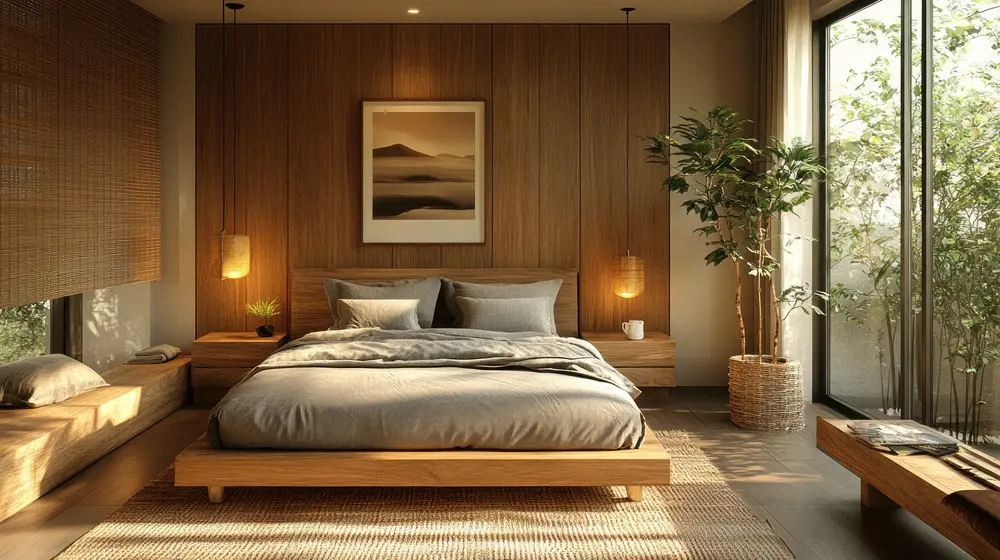
Creating a peaceful, well-balanced bedroom starts with choosing the right bed frame. Japandi design, a seamless fusion of Japanese minimalism and Scandinavian functionality, provides an ideal foundation for a tranquil sleep space. With its focus on simplicity, natural materials, and mindful craftsmanship, Japandi-style furniture helps transform any bedroom into a calming retreat. Dive into the key qualities of Japandi bed frames and discover ten standout designs to inspire your next restful sanctuary.
What is Japandi Style?
Japandi is a design philosophy that fuses the Japanese concept of "wabi-sabi," which embraces imperfection and transience, with the Scandinavian principle of "hygge," which prioritizes comfort and coziness. This hybrid style emphasizes natural materials, minimalist aesthetics, and functional design to create serene and harmonious living spaces.
Historical Background of Japandi Bed Frames
Before exploring the best Japandi bed frame designs, let's take a step back and discover how Japanese and Scandinavian aesthetics merged to create this beautifully balanced style.
Scandinavian Influence
Scandinavian design from the 1950s—1970s emphasized clean lines, functionality, and natural materials. Originating from Denmark, Sweden, and Norway, this design tradition was shaped by visionary designers like Alvar Aalto and Hans J. Wegner, who pioneered furniture that balanced beauty and utility. Modern Scandinavian bed frames typically feature minimalist wooden construction that showcases the natural beauty of solid wood. Elevated on legs to create a "floating" appearance, these frames promote lightness and airiness.
In recent years, there has been a growing emphasis on sustainability, with brands like IKEA promoting environmentally conscious materials and renewable resources in bed frame design.
Japanese Influence
Traditional Japanese bedding consisted of futons laid directly on tatami mats. Even as Western-style beds became more common in the 1950s, low beds and wooden slat-style beds gained widespread popularity. This shift aligned with the Japanese lifestyle, which remains deeply accustomed to floor-level sleeping and emphasizes efficient use of space.
Contemporary designs (from around 2010) blend this heritage with modern needs—offering compact beds for single living, beds with built-in storage, and floor beds suited to smaller urban spaces. This evolution reflects Japan's shifting lifestyles and aging demographics, including demand for adjustable beds and sleep solutions designed for assisted living.
Key Features of Japandi Bed Frames
Low-profile Platform Design
Japandi bed frames sit low to the ground, fostering a sense of stability and openness. This design reduces visual clutter, making the room feel more spacious and calm. It also reflects traditional Japanese sleeping arrangements, such as futons laid directly on tatami mats, lending an authentic touch to the Japandi aesthetic. The low profile encourages a restful atmosphere by keeping the bed unobtrusive and connected to the room's natural flow.
Use of Natural Materials
Japandi bed frames typically embrace natural, sustainable materials like solid oak, walnut, or bamboo, reflecting the style's commitment to simplicity and eco-consciousness. The visible grain and natural imperfections of the wood celebrate authenticity and sustainability, creating a tactile connection to nature. Beyond the wood itself, these bed frames often feature finishes that highlight the material's natural beauty without heavy varnishes or paints, allowing the raw essence of the wood to shine.
Simple and Harmonious Design
The hallmark of Japandi bed frames is their elegant simplicity and harmonious proportions. The design philosophy favours clean, straight lines and gently rounded edges that convey balance and tranquility. The bed frames embody a perfect union of form and function, promoting harmony and tranquility, seamlessly blending with other minimalist elements in the room. This simplicity allows the bed to serve as a calming focal point without overwhelming the space.
Top 10 Recommended Japandi Bed Frame Designs
1. Japanese Joinery Bed
Crafted using traditional Japanese joinery techniques, this bed frame boasts a simple yet sturdy structure without the need for nails, screws or adhesives. The result is a meticulously hand-crafted structure that showcases precision craftsmanship and timeless appeal. Each connection is both functional and decorative, with exposed joinery adding visual interest.
The absence of metal hardware reinforces the natural, unadulterated essence of the wood, aligning perfectly with both Japanese and Scandinavian aesthetics.
Styling Tip: Enhance the refined craftsmanship of the exposed joinery and natural wood grain by pairing it with layers of soft neutrals and dark-toned navy textiles. The contrast between the crisp white bedding and dark blue throw creates a serene yet sophisticated Japandi palette.

2. Tatami-based Bed Frame
This design incorporates authentic tatami mats, woven straw flooring traditionally used in Japanese homes, into the bed base. The tactile, earthy surface offers a grounding sleep experience and adds a distinctive Japanese character to the bedroom. It also has the added feature of being comfortable to lie on directly, eliminating the need for a mattress and embracing a more minimalist way of living.
Tatami encourages a connection to the floor and nature, echoing Japandi's embrace of simplicity and calm. Its muted color and natural texture pair beautifully with soft Nordic tones.
Styling Tip: Enhance the serene atmosphere with washi paper lamps and a small bonsai tree to emphasize the Japanese aesthetic.
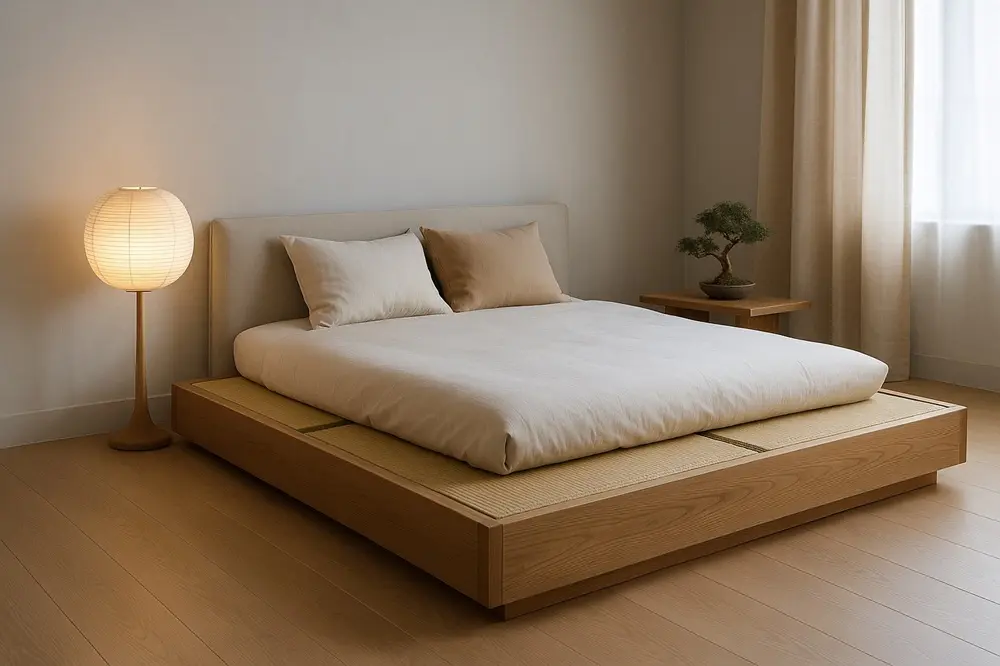
3. Solid Wood Platform Bed Frame
Constructed from solid hardwoods like oak, walnut, or ash, this platform bed is a timeless staple in Japandi interiors. With a sturdy, elevated surface and clean-lined profile, it provides durability and elegance in equal measure.
The natural grain of the wood brings warmth and a sense of grounding, while the clean design honors minimalist sensibilities.
Styling Tip: Layer with wool blankets and neutral-colored rugs to create a cozy contrast in textures.
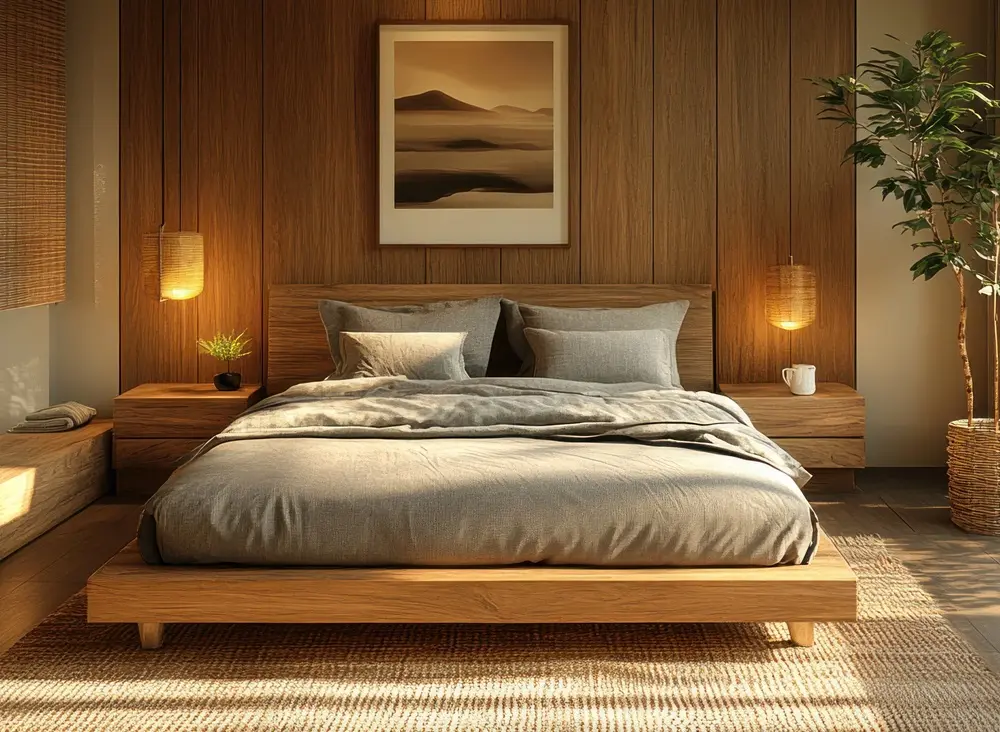
4. Storage-equipped Bed Frame
Designed with built-in drawers or hidden compartments, this frame merges form and function while preserving the minimalist ethos. It is ideal for smaller bedrooms or shared bedrooms where space must be maximized.
By supporting a serene and uncluttered environment, it complements Japandi's focus on simplicity, calm, and purposeful living.
Styling Tip: Pair with minimalist side tables to maintain a clean and organized bedroom layout.

5. Bamboo Bed Frame
This eco-conscious design uses bamboo, a fast-growing and renewable resource, known for its strength and flexibility. With its light tone and soft texture, bamboo frames add a subtle organic feel to any bedroom.
Bamboo's sustainable nature and visual lightness echo both wabi-sabi values and Scandinavian eco-minimalism.
Styling Tip: Complement with natural materials like rattan baskets and indoor plants to enhance the organic feel.
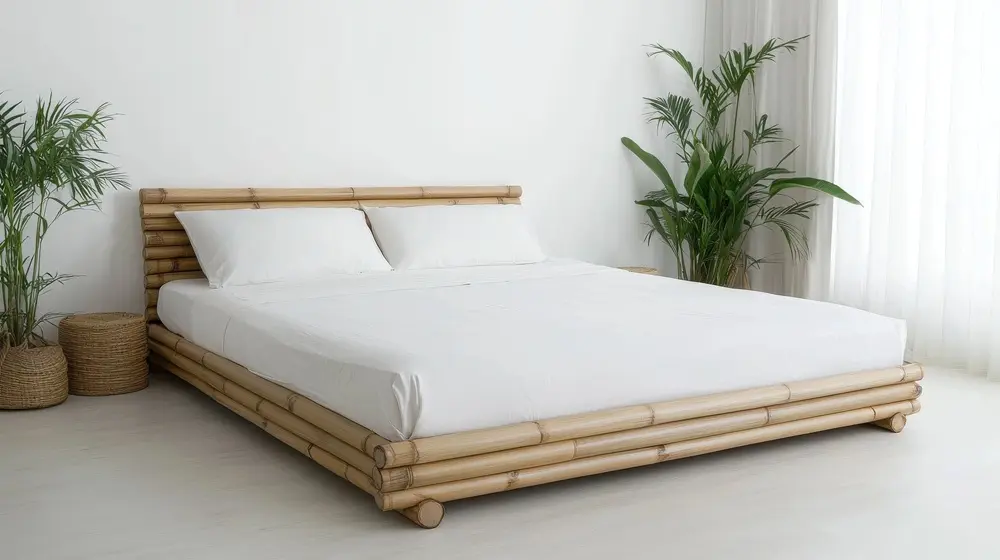
6. Slatted Bed Frame (Sunoko Bed)
Inspired by sunoko—the slatted wooden platforms traditionally used in Japanese bathhouses and verandas—this bed frame uses evenly spaced wood slats for ventilation and minimalist flair.
Its simplicity and lightness bring structure without heaviness, offering breathability in both function and design.
Styling Tip: Pair with a thin futon mattress and neutral-toned bedding to maintain a minimalist aesthetic.

7. Floating Bed Frame
Supported by recessed legs or a concealed base, this frame gives the illusion of hovering above the floor. While it adds a slightly futuristic look, the restrained design ensures it does not break from Japandi's calming visual language.
It creates a sense of lightness and modernity while keeping details simple, offering a contemporary twist on traditional minimalism.
Styling Tip: Incorporate under-bed lighting and monochromatic bedding to accentuate the floating effect and serene ambiance.
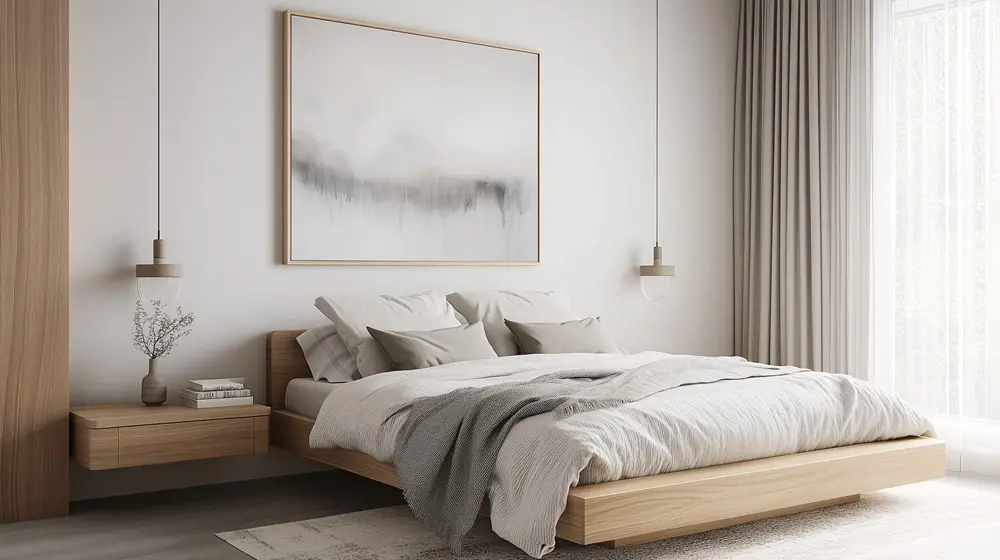
8. Low-profile Bed Frame
This bed frame sits close to the floor, echoing traditional Japanese futon culture. The low height visually enlarges the room and promotes a calming, grounded presence.
Low furniture brings the focus downward, reinforcing serenity and stillness in the room—a fundamental aspect of Japanese design and mindfulness.
Styling Tip: Use light-colored bedding and minimal decor to emphasize the spaciousness and tranquility.
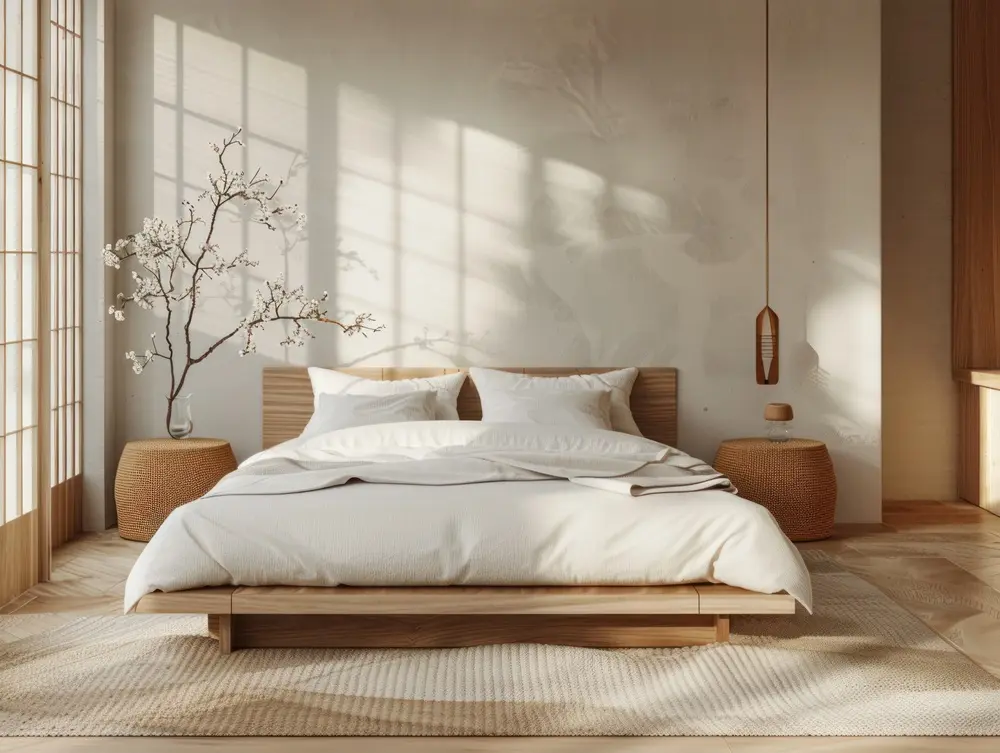
9. Upholstered Bed Frame
This version features fabric-wrapped headboard, usually in soft, natural tones like oatmeal, taupe, or gray. The frame itself may be crafted from wood or similarly upholstered, creating a cozy visual contrast to the clean lines and organic feel of Japandi design.
Though more common in Scandinavian homes, muted textiles and clean lines align beautifully with Japandi's focus on understated comfort and visual harmony.
Styling Tip: Pair with neutral fabrics and natural wood nightstands to add warmth and harmony.
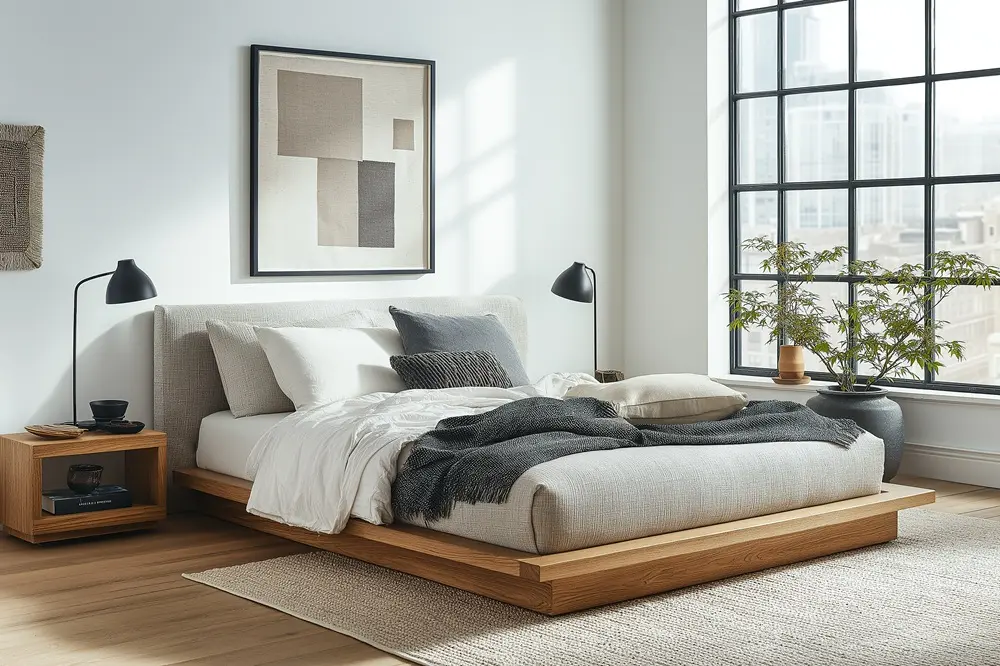
10. Reclaimed Wood Bed Frame
Constructed from repurposed wood, this frame brings unique character and sustainability to the space. Each piece carries its own history, with visible grain patterns and imperfections that enhance its charm.
It embodies both sustainability and wabi-sabi—celebrating impermanence, natural aging, and imperfect beauty.
Styling Tip: Highlight the natural texture with soft, earth-toned bedding and woven storage baskets.
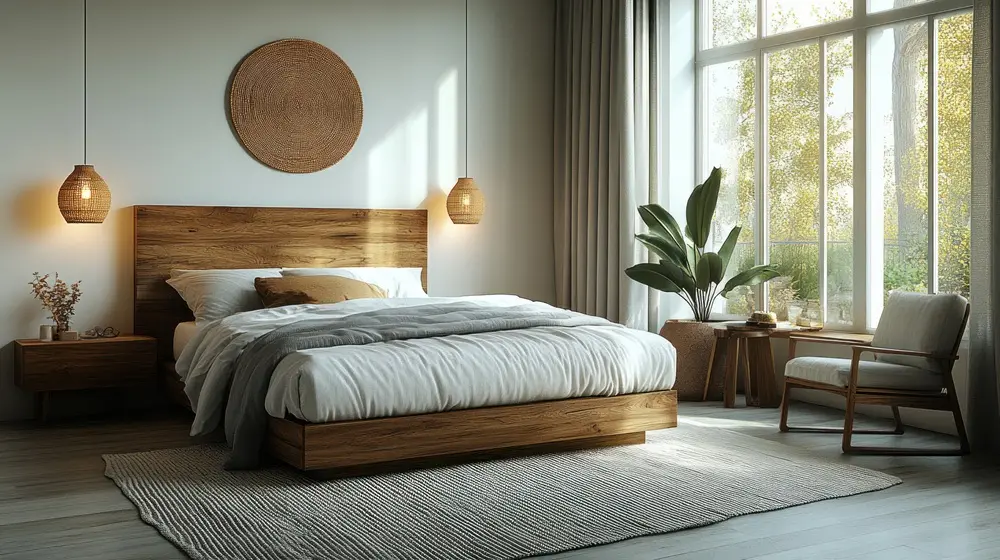
Frequently Asked Questions (FAQ)
Designing a Japandi-style bedroom may seem intricate, but it does not require a complete overhaul. Whether you are working with existing furniture or starting fresh, small intentional changes can help you capture the serene, minimalist beauty of Japandi design. Here are answers to some common questions to help guide your transformation.
Q1. Can I transform my existing iron bed frame into a Japandi-style piece?
Absolutely. If your iron frame is black or gray, it naturally lends itself to the Japandi aesthetic. If it is a different color, consider painting it black gray or draping it with a cloth in a muted, Japandi-inspired tone. Complement it with monochromatic bedding that transitions from charcoal to soft gray, capturing the quiet elegance of sumi-e ink wash paintings. To soften the look and avoid a cold impression, through natural textures like woven rugs, linen throws and potted plants.
Q2. I have a Japandi bed frame. What kind of decor and furnishings should I use to match the style throughout the room?
To create a cohesive Japandi-style bedroom, focus on simplicity, natural materials, and muted tones. Start with bed linens made from linen or organic cotton in shades like beige, ivory, or stone. Swap out any bright or patterned curtains for solid neutrals. Add warmth and texture with natural wood furniture, such as bedside tables or shelves. Incorporate decorative items made from organic materials—bamboo or rattan baskets, ceramic vases, or handwoven rugs. Abstract or nature-inspired wall art in soft, neutral tones can enhance the mood without overwhelming the space. Finish with a few well-placed houseplants and soft lighting, such as washi paper lamps, to reinforce the calm, grounded atmosphere that defines Japandi design.
Q3. Japandi-style bed frames are low to the ground—are they practical for daily use?
Yes. The low height of Japandi bed frames is intentional, contributing to a sense of calm and stability in the room. This design reflects both the Japanese tradition of floor-level sitting and the Scandinavian preference for clean, grounded aesthetics.
From a practical perspective, low beds reduce the risk of injury from falls, making them a safe choice for households with children or pets. Visually, they lower the eye line, which can make ceilings appear higher and rooms feel more open and airy.
If ease of getting in and out of bed is a concern, consider adjusting the height by layering a thicker mattress or adding a supportive rug beneath the frame. This way, you can balance visual harmony with everyday comfort.
Q4. How can I incorporate technology into a Japandi bedroom without disrupting its calm atmosphere?
You can seamlessly integrate technology by choosing devices with minimalist designs and neutral colors that complement the room's color palette. Go for fabric-covered speakers and smart lighting that blend harmoniously with a simple wooden bed frame. Conceal wires under the bed and select minimalist nightstands with built-in USB ports to keep everything tidy and unobtrusive. This approach lets you enjoy modern comforts while preserving the tranquil, balanced feel of a Japandi bedroom.
Q5. Can Japandi style work in a bedroom with carpet flooring?
Yes. Although wooden or tatami floors are typical in Japandi design, carpet can work well if you choose wisely. Opt for neutral-colored, low-pile carpets to keep the space feeling light and airy. Selecting a bed frame with legs helps maintain the lightness that is unique to Japandi without making it visually too heavy. To add texture and depth, layer natural fiber rugs like jute or wool, enhancing warmth while staying true to Japandi's natural, minimalist aesthetic.
For more insights on integrating modern elements into Japandi interiors, check out this Japandi house trends guide.
The Harmony of Design and Comfort
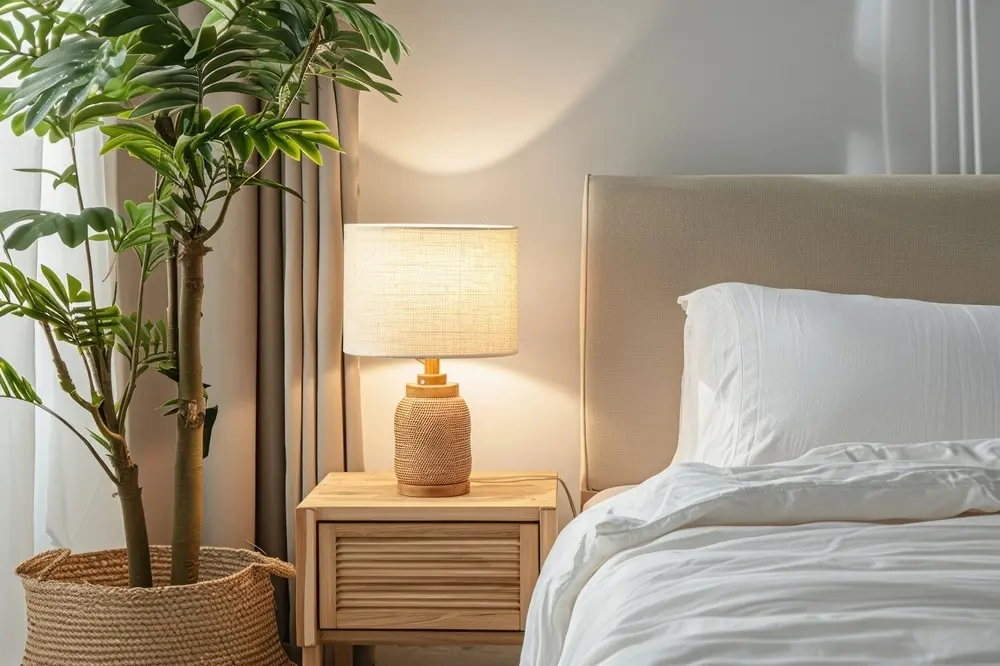
Japandi bed frames are more than just furniture—they are a foundation for intentional living. Whether you are drawn to traditional joinery, natural materials, or low-profile silhouettes, each design reflects the timeless values of simplicity and tranquility. By embracing Japandi principles in your bedroom, you create not just a space to sleep, but a sanctuary that restores and inspires every day.
*Some of the images featured in this article were created using generative AI.

